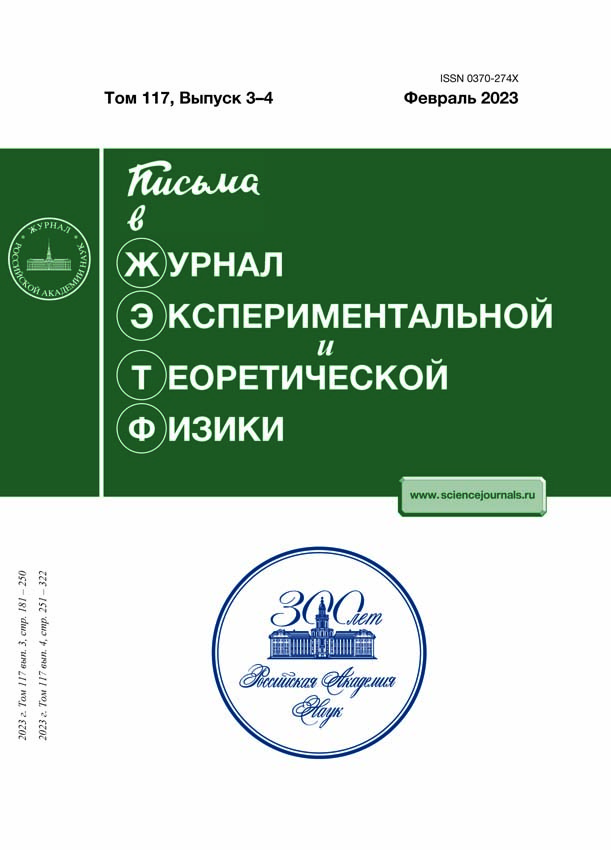Effect of Disorder on Magnetotransport in Semiconductor Artificial Graphene
- Autores: Tkachenko O.A.1, Tkachenko V.A.1,2, Baksheev D.G.2, Sushkov O.P.3
-
Afiliações:
- Rzhanov Institute of Semiconductor Physics, Siberian Branch, Russian Academy of Sciences
- Novosibirsk State University
- School of Physics, University of New South Wales
- Edição: Volume 117, Nº 3-4 (2) (2023)
- Páginas: 228-234
- Seção: Articles
- URL: https://rjeid.com/0370-274X/article/view/663514
- DOI: https://doi.org/10.31857/S1234567823030084
- EDN: https://elibrary.ru/OXGCHZ
- ID: 663514
Citar
Texto integral
Resumo
Magnetotransport in mesoscopic samples with semiconductor artificial graphene has been simulated within the Landauer–Büttiker formalism. Model four-terminal systems in a high-mobility two-dimensional electron gas have a square shape with a side of 3–5 μm, which is filled with a short-period (120 nm) weakly disordered triangular lattice of antidots at the modulation amplitude of the electrostatic potential comparable with the Fermi energy. It has been found that the Hall resistance
in the magnetic field range of B = 10–50 mT has a hole plateau
, where R0 = h/2e2 = 12.9 kΩ, at carrier densities in the lattice below the Dirac point n < n1D and an electron plateau
at n > n1D. Enhanced disorder destroys the plateaus, but a carrier type (electrons or holes) holds. Long-range disorder at low magnetic fields suppresses quantized resistance plateaus much more efficiently than short-range disorder.
Sobre autores
O. Tkachenko
Rzhanov Institute of Semiconductor Physics, Siberian Branch, Russian Academy of Sciences
Email: otkach@isp.nsc.ru
630090, Novosibirsk, Russia
V. Tkachenko
Rzhanov Institute of Semiconductor Physics, Siberian Branch, Russian Academy of Sciences; Novosibirsk State University
Email: otkach@isp.nsc.ru
630090, Novosibirsk, Russia; 630090, Novosibirsk, Russia
D. Baksheev
Novosibirsk State University
Email: otkach@isp.nsc.ru
630090, Novosibirsk, Russia
O. Sushkov
School of Physics, University of New South Wales
Autor responsável pela correspondência
Email: otkach@isp.nsc.ru
2052, Sydney, Australia
Bibliografia
- D.Q. Wang, D. Reuter, A.D. Wieck, A.R. Hamilton, and O. Klochan, Appl. Phys. Lett. 117, 032102 (2020).
- O.A. Tkachenko, V.A. Tkachenko, I. S. Terekhov, and O.P. Sushkov, 2D Mater. 2, 014010 (2015).
- Y. Hatsugai, T. Fukui, and H. Aoki, Phys. Rev. B 74, 205414 (2006).
- Y. Zheng and T. Ando, Phys. Rev. B 65, 245420 (2002).
- O.A. Tkachenko and V.A. Tkachenko, JETP Lett. 99, 204 (2014).
- O.A. Tkachenko, V.A. Tkachenko, D.G. Baksheev, and O.P. Sushkov, JETP Lett. 116, 616 (2022).
- L. N'advorn'ık, M. Orlita, N.A. Goncharuk, L. Smr˘cka, V. Nov'ak, V. Jurka, K. Hru˘ska, Z. V'yborn'y, Z.R. Wasilewski, M. Potemski, and K. V'yborn'y, New J. Phys. 14, 053002 (2012).
- C.W. Groth, M. Wimmer, A.R. Akhmerov, and X. Waintal, New J. Phys. 16, 063065 (2014).
- M. B¨uttiker, Phys. Rev. Lett. 57, 1761 (1986).
Arquivos suplementares










